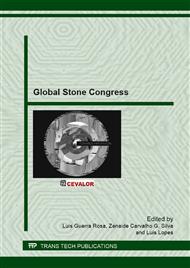[1]
A. Konin, R. François, G. Arliguie: Penetration of chlorides in relation to the microcracking state into reinforced ordinary and high strength concrete, Materials and Structures 31(5) (1998) pp.310-316.
DOI: 10.1007/bf02480672
Google Scholar
[2]
Z.S.G. Silva, J.A.R. Simão: The role of salt fog on alteration of dimension stone, Construction and Building Materials 23(11) (2009) pp.3321-3327.
DOI: 10.1016/j.conbuildmat.2009.06.044
Google Scholar
[3]
M. Angeli, J. -P. Bigas, D. Benavente, B. Menéndez, R. Hébert, C. David: Salt crystallization in pores: quantification and estimation of damage, Environmental Geology 52 (2007) pp.205-213.
DOI: 10.1007/s00254-006-0474-z
Google Scholar
[4]
P. A. Maurice-Johnsson: Use of AFM in experimental surface geochemistry, Mineralogical Magazine 58A (1994) pp.575-576.
DOI: 10.1180/minmag.1994.58a.2.36
Google Scholar
[5]
P. Theoulakis, A. Moropoulou: Microstructural and mechanical parameters determining the susceptibility of porous building stones to salt decay, Construction and Building Materials 11(1) (1997) pp.65-71.
DOI: 10.1016/s0950-0618(96)00029-3
Google Scholar
[6]
D. Benavente, N. Cueto, J. Martínez-Martínez, M. A. García del Cura, J. C. Cañaveras: The influence of petrophysical properties on the salt weathering of porous building stones, Environmental Geology 52(2) (2007) pp.215-224.
DOI: 10.1007/s00254-006-0475-y
Google Scholar
[7]
G.R. Meira, C. Andrade, C. Alonso, I.J. Padaratz, J.C. Borba: Modelling sea-salt transport and deposition in marine atmosphere zone – A tool for corrosion studies, Corrosion Science 50(9) (2008) pp.2724-2731.
DOI: 10.1016/j.corsci.2008.06.028
Google Scholar
[8]
M. Urosevic, E. Sebastián-Pardo, C. Cardell: Rough and polished travertine building stone decay evaluated by a marine aerosol ageing test, Construction and Building Materials 24(8) (2010) pp.1438-1448.
DOI: 10.1016/j.conbuildmat.2010.01.011
Google Scholar
[9]
EN 13755: 2005 European standard - Natural stone test methods. Determination of water absorption at atmospheric pressure, European Committee for Standardization (CEN, Brussels).
Google Scholar
[10]
C. Anjinho, P.M. Amaral, Z.C.G. Silva: A transformação de rochas ornamentais – Acabamento e controlo de qualidade, Arquitectura e Vida, no. 80 (2007) pp.134-139.
Google Scholar
[11]
T.T. Chau: A review of techniques for measurement of contact angles and their applicability on mineral surfaces, Minerals Engineering 22(3) (2009) p.213–219.
DOI: 10.1016/j.mineng.2008.07.009
Google Scholar
[12]
E.A. Vogler: Structure and reactivity of water at biomaterial surfaces, Advances in Colloid and Interface Science 74(1-3) (1998) pp.69-117.
DOI: 10.1016/s0001-8686(97)00040-7
Google Scholar
[13]
G. Binnig, H. Rohrer, Ch. Gerber, E. Weibel: Tunneling through a controllable vacuum gap, Applied Physics Letters 40(2) (1982) p.178–180.
DOI: 10.1063/1.92999
Google Scholar
[14]
J. Verran, D.L. Rowe, D. Cole, R.D. Boyd: The use of the atomic force microscope to visualise and measure wear of food contact surfaces, International Biodeterioration & Biodegradation 46(2) (2000) pp.99-105.
DOI: 10.1016/s0964-8305(00)00070-6
Google Scholar
[15]
K.C. Khulbe, C.Y. Feng, T. Matsuura: Synthetic Polymeric Membranes – Characterization by Atomic Force Microscopy (Springer, Berlin, Germany, 2008).
Google Scholar
[16]
Z.S.G. Silva, J.A.R. Simão: Syenite as ornamental stone – Quality and alteration, in Proceedings of the 8th IAEG Congress, Vancouver, Moore & Hungr (eds. ), Balkema (1998) pp.2897-2901.
Google Scholar
[17]
A. Arnold, A. Kueng: Crystallization and habits of salt efflorescences on walls – Part I. Methods of investigation and and habits, in Proceedings of the 5th International Congress on the Deterioration and Conservation of Stone, ed. G. Félix, Presses Polytechniques Romandes, Lausanne (1985).
Google Scholar
[18]
A. Arnold, K. Zehnder: Crystallization and habits of salt efflorescences on walls – Part II. Conditions of crystallization. in Proceedings of the 5th International Congress on the Deterioration and Conservation of Stone, ed. G. Félix, Presses Polytechniques Romandes, Lausanne (1985).
Google Scholar


